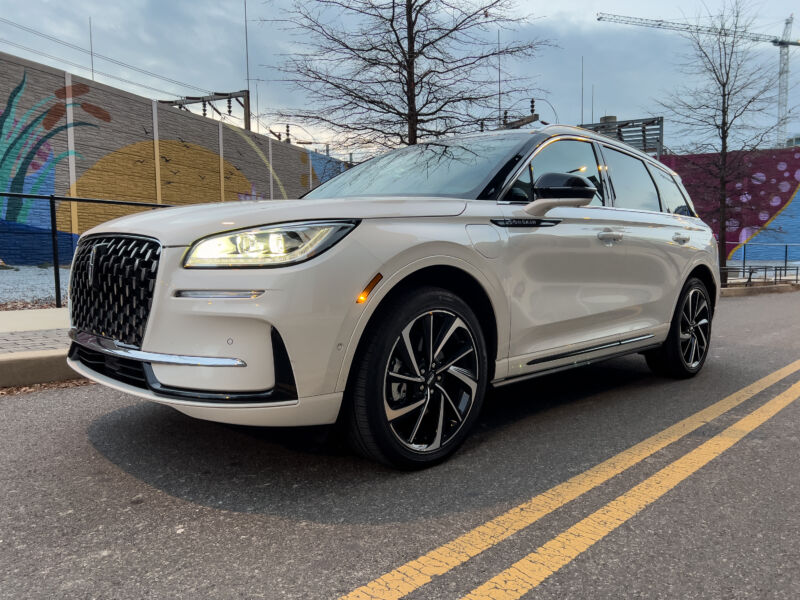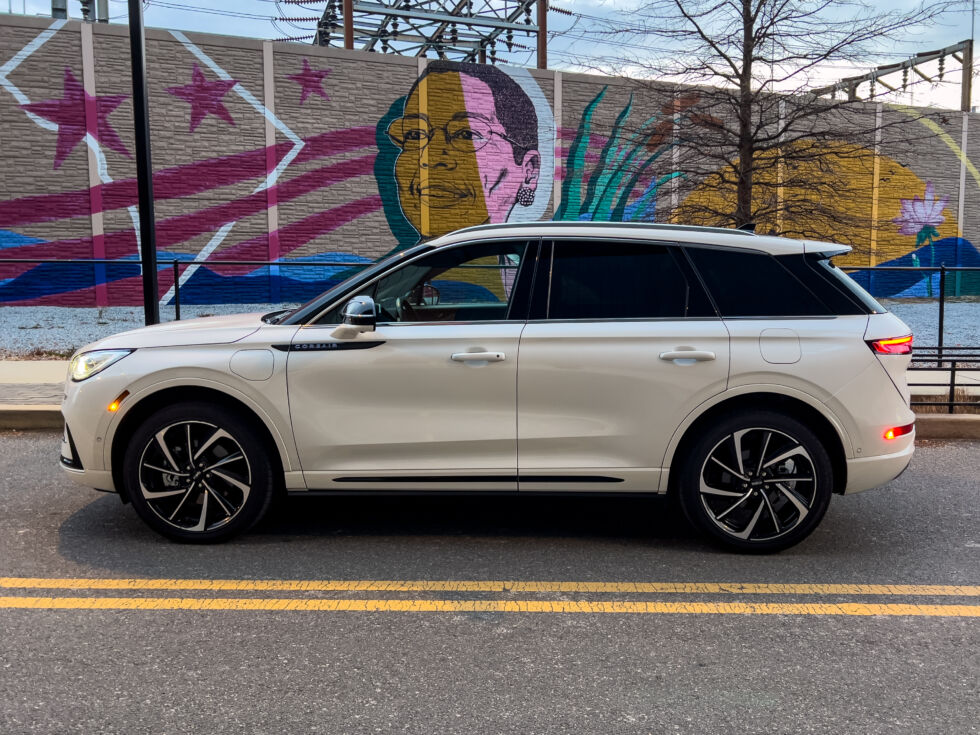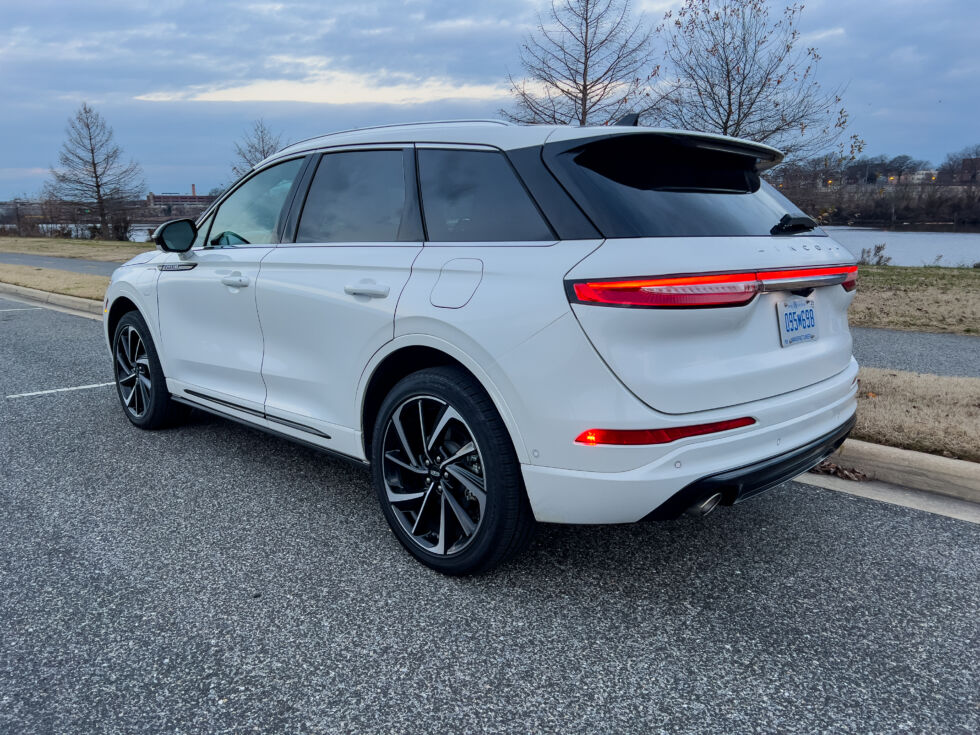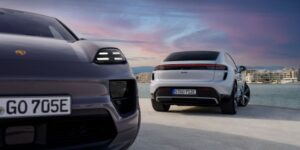
Jonathan Gitlin
It probably hasn’t escaped notice that electric vehicles, having captured everyone’s attention, are having a bit of a slide into what Gartner calls “the trough of depression.” But as skeptics push back on battery EVs, another style of electrified car looks set to travel back up the slope of enlightenment. Plug-in hybrids are finding their second wind, as automakers and regulators look to PHEVs as a way to reduce transport-related carbon emissions.
Lincoln’s Corsair Grand Touring is not a particularly new PHEV, but since we hadn’t tested one yet and there was an example on the local press fleet, it seemed prudent to schedule a week with this compact crossover from one of America’s luxury brands.
The first thing to note is that, despite the way it might look in photos, this is not a huge land barge. The Corsair is 181.4 inches (4,608 mm) long, 76.4 inches (1,941 mm) wide, and 64.1 inches (1,628 mm) tall, so about the same size as a Toyota RAV4, or six inches shorter than a Tesla Model Y. The shape uses plenty of curved edges, dominated by the large Lincoln grille up front, with a hint of late-teens Audi SUV to it.
Under the hood you’ll find a 165 hp (123 kW) 2.5 L four-cylinder gasoline engine, which uses the more-efficient Atkinson cycle and drives the front wheels via a PowerSplit electric CVT transmission. (This uses a pair of electric motors and a single planetary gear set, with no clutches or torque converter or rubber belts.) The rear wheels are powered by a permanent magnet synchronous motor that generates 67 hp (50 kW) and 110 lb-ft (150 Nm). (Lincoln chose not to disclose a combined torque figure for the powertrain.)

Jonathan Gitlin
The electric motor is powered by a 14.4 kWh lithium-ion traction battery, made up of 84 prismatic cells. Recharging times are 10–11 hours if you only have access to a 120 V socket, or between 3–4 hours with a 240 V level 2 charger. In practice, 3.5 hours on a level 2 charger was sufficient to give me a full battery. Should you wish, you can also set the Corsair Grand Touring to Preserve mode, which uses spare engine power to top up the battery, to about 75 percent state of charge. (Like most PHEVs, the Corsair Grand Tourer has a reserve that means even if it doesn’t have a sufficient state of charge to operate on electric power alone, the powertrain will still function as a hybrid, and the electric motor will still engage at low speeds and as a boost.)
When fully charged, the EPA rating gives the Corsair Grand Touring an electric-only range of 27 miles (43 km). But our time with the Corsair Grand Touring was scheduled for late December, and the cold weather at the time had other thoughts about that. After a full charge, the littlest Lincoln reported 23 miles of electric range, which dropped to 21 miles after a couple of blocks. Like BEVs, PHEV powertrains also suffer in terms of range when the temperatures approach freezing.
In fact, all vehicles suffer from worse economy in freezing temperatures, and the US Department of Energy points out that even hybrids can suffer up to 45 percent worse efficiency on short trips in cold weather. Gas mileage is rated at a combined 33 mpg (7.13 L/100 km), but here I actually saw as high as 38 mpg (6.19 L/100 km) on short trips even with a depleted battery. The cold weather also meant that the car would fire up the engine even when there was charge in the battery, presumably to help run the heater and also battery cooling—another common PHEV trait in winter.

Jonathan Gitlin
For most of the week, I used either Normal or Conserve drive modes—the latter is the eco setting with more gentle throttle response. There’s also Excite mode, which keeps the engine running and the battery cooled for better performance, plus there’s a sharper throttle response and more weight to the steering. But the Corsair Grand Touring still weighs 4,397 lbs (1,994 kg), 561 lbs (255 kg) more than the non-hybrid AWD Corsair, and driving it like a sports car didn’t seem in keeping with the Lincoln’s vibes.
On the road, the ride was smooth and well-controlled, although definitely on the softer side of things. Happily, there wasn’t excessive road noise from the tires or air flow around the car at highway speeds. Lincoln says its designers “obsessed over each detail to create a sanctuary for the senses,” and in that regard they did a pretty good job.
I also have to commend the interior design team—the mix of tan leather and aluminum trim work well together. Unfortunately, with just 12,000 miles on the odometer, our test car creaked and rattled more than any other car I’ve driven in the last few years. The culprit seemed to be the dashboard, or something behind it, which registered its protest over each bump or jolt that made it past the adaptive suspension.
-
Jonathan Gitlin -
There’s up to 43.2 inches (1,097 mm) of rear leg room.
Jonathan Gitlin -
There’s 26.9 cubic feet (762 L) of cargo volume with the rear seats in use, or 56.2 cubic feet (1,591 L) with the rear seats folded down.
Jonathan Gitlin
For a model that has been in production for some time, it’s not unreasonable to expect better quality, especially with a starting price of $53,925.
In fact, our test car tipped the scales at $65,390, largely due to the $8,675 Collection III package that added (among other features) Lincoln ActiveGlide, the brand’s name for parent company Ford’s BlueCruise hands-free driver assist. This works as well as BlueCruise in other recent Fords we’ve tested and only operates on premapped restricted-access highways, and the car’s UI does a good job of indicating which mode you’re in so there’s no confusion.
While I’m praising UI stuff, I’ll add the infotainment to the list—the interface and fonts are clear but also aesthetically pleasing and are in keeping with the car’s vaguely art deco look and feel. Amazon Alexa is included as a voice assistant (with three years of free connectivity), but I imagine most drivers will just use Apple CarPlay or Android Auto.
Despite the cold weather and its deleterious effect on battery range, I finished my week with warm feelings toward the Corsair Grand Touring. It’s an example of a luxury car that doesn’t try to be a sports car as well, and I’ve already described how much I like the interior. But the amount of creaks and rattles in the cabin aren’t really acceptable for a car with just a year under its belt, and the sticker price is quite high, although the car is eligible for a $3,750 IRS clean vehicle tax credit.


























